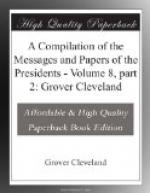The Congress of the United States have never passed an act imperatively directing that the public moneys shall be kept in any particular place or places. From the origin of the Government to the year 1816 the statute book was wholly silent on the subject. In 1789 a Treasurer was created, subordinate to the Secretary of the Treasury, and through him to the President. He was required to give bond safely to keep and faithfully to disburse the public moneys, without any direction as to the manner or places in which they should be kept. By reference to the practice of the Government it is found that from its first organization the Secretary of the Treasury, acting under the supervision of the President, designated the places in which the public moneys should be kept, and especially directed all transfers from place to place. This practice was continued, with the silent acquiescence of Congress, from 1789 down to 1816, and although many banks were selected and discharged, and although a portion of the moneys were first placed in the State banks, and then in the former Bank of the United States, and upon the dissolution of that were again transferred to the State banks, no legislation was thought necessary by Congress, and all the operations were originated and perfected by Executive authority. The Secretary of the Treasury, responsible to the President, and with his approbation, made contracts and arrangements in relation to the whole subject-matter, which was thus entirely committed to the direction of the President under his responsibilities to the American people and to those who were authorized to impeach and punish him for any breach of this important trust.




